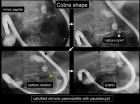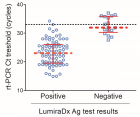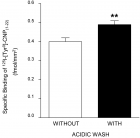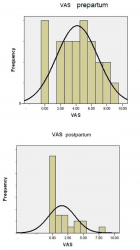Abstract
Research Article
Unconventional powder method is a useful technique to determine the latent fingerprint impressions
Harshita Niranjan, Shweta Rai, Kapil Raikwar, Chanchal Kamle and Rakesh Mia*
Published: 23 August, 2022 | Volume 6 - Issue 1 | Pages: 045-048
Background: Fingerprint development techniques are being used for a long time and are considered one among the oldest methods in forensic science used to identify suspects. Fingerprints are one of the most significant types of physical evidence. There are various types of fingerprint patterns such as visible, plastic and latent. In criminal investigation cases, chance fingerprint impressions are mostly found at the crime scene. These prints are generally invisible and therefore require several development methods. The powder dusting technique of developing fingerprints involves the application of fine powder on the impression of the print with the help of a brush such as glass fiber or a camel hair brush.
Main text: This paper rather focuses on various unconventional powder methods than the widely used conventional ones. This will help identify other cheaper, non-toxic powders that are commonly available as an alternative to the expensive, toxic ones. The author’s main aim is to provide a collective review of the work of other scientists in order to identify everyday materials, commonly available that can be used as possible means to develop a fingerprint impression.
Conclusion: For a better result, the unconventional powder is used on different surfaces i.e. porous, non-porous, and semi-porous for latent fingerprint impressions. After developing impressions on different surfaces, we conclude our result that unconventional powder is very useful.
Read Full Article HTML DOI: 10.29328/journal.jfsr.1001035 Cite this Article Read Full Article PDF
Keywords:
Fingerprint; Fingerprint development; Latent fingerprint; Powder method
References
- Garg R, Kumari H, Kaur R. A new technique for visualization of latent fingerprints on various substrates using powder from turmeric: A rhizomatous herbaceous plant (Curcuma longa). Egyptian Journal of Forensic Science. 2011; 1: 53-57.
- Nigam K, Das T, Harshey A, kumar A, Kapoor N, Yadav V, Srivastava A. Effectiveness of Talcum powder for decipherment of latent fingerprint on various substrates. Asian Journal of Chemistry. 2021.
- Thakur P, Garg R. New developing reagent for latent finger mark visualization: Fuller’s earth. Egyptian Journal Forensic Science. 6: 449-58.
- Champod C, Lennard C, Margot P, Stoilovic M. Fingerprints and other ridge skin Impressions, Chapter 4. CRC Press, Washington D.C; 2004.
- Garg RK. Latent fingerprints in forensic science. In: Veeraraghavan V, editor. Handbook of forensic science. New Delhi: Selective and Scientific Books Publishers; 2004; 77-85.
- Saroa JS, Sodhi GS, Garg RK. Evaluation fingerprint powders. J Forensic Ident. 2006; 56(2):186-197.
- Mia R, Panchal V, Gokhale C. Using Salt & Sugar Powder to Development Hidden Fingerprint Impressions at the Crime Scene. International Journal of Forensic Sciences. 2021; 6(2).
- Rohatgi R, Kapoor AK. New Visualizing Agents for Developing of the Latent Fingerprints on the Various Porous and Non-Porous Surfaces by Using Different Household Food Items. Asian Journal of Science and Applied Technology. 2014; 3(2): 33-38.
- Badiye A, Kapoor N. Efficacy of Robin® powder blue for the latent fingerprints development on the surfaces. Egyptian Journal of Forensic Science. 2015; 5(4):166-173.
- Thakur P, Garg RK. New developing reagent for the latent fingermark visualization: Fuller earth. Egyptian Journal of Forensic science. 2016; 6(4): 449-458.
- Dhunna A, Anand S, Aggarwal A, Agarwal A, Verma P, Singh U. New visualization agents to reveal the hidden secrets of the latent fingerprint. Egyptian Journal of Forensic Science. 2018; 8(1): 1-6.
- Kumari H, Kaur R, Garg RK. New Visualizing agents for the latent fingerprints: Synthetic food and festival color. Egyptian Journal of Forensic Science. 2011; 1(3-4): 133-139.
- Singh K, Sharma S, Garg RK. Visualization of latent fingerprints using the silica Gel: new technique. Egyptian Journal of Forensic Science. 2013; 3(1): 20-25.
- Ferguson S, Nicholson L, Farrugia K, Bremner D, Gentles D. A preliminary Investigation onto a acquisition of fingerprints on Foods. Science & Justice. 2013; 53(1), 67-72.
- Herschel WJ. Skin furrows of the hand. Nature. 1880; 23:76.
Figures:
Similar Articles
-
Difference between conventional and modern methods for examination of fingerprintsAmbati Ramesh Babu*. Difference between conventional and modern methods for examination of fingerprints. . 2021 doi: 10.29328/journal.jfsr.1001025; 5: 037-040
-
Unconventional powder method is a useful technique to determine the latent fingerprint impressionsHarshita Niranjan,Shweta Rai,Kapil Raikwar,Chanchal Kamle,Rakesh Mia*. Unconventional powder method is a useful technique to determine the latent fingerprint impressions. . 2022 doi: 10.29328/journal.jfsr.1001035; 6: 045-048
-
A Comparative Analysis of Traditional Latent Fingerprint Visualization Methods and Innovative Silica Gel G Powder ApproachBhoomi Aggarwal*. A Comparative Analysis of Traditional Latent Fingerprint Visualization Methods and Innovative Silica Gel G Powder Approach. . 2024 doi: 10.29328/journal.jfsr.1001063; 8: 040-046
-
Development of Latent Fingerprints Using Food Coloring AgentsKallu Venkatesh,Atul Kumar Dubey,Bhawna Sharma. Development of Latent Fingerprints Using Food Coloring Agents. . 2024 doi: 10.29328/journal.jfsr.1001070; 8: 104-107
Recently Viewed
-
Various Theories of Fast and Ultrafast Magnetization DynamicsManfred Fähnle*. Various Theories of Fast and Ultrafast Magnetization Dynamics. Int J Phys Res Appl. 2024: doi: 10.29328/journal.ijpra.1001101; 7: 154-158
-
Forest History Association of WisconsinEd Bauer*. Forest History Association of Wisconsin. J Radiol Oncol. 2024: doi: 10.29328/journal.jro.1001071; 8: 093-096
-
Synthesis of Carbon Nano Fiber from Organic Waste and Activation of its Surface AreaHimanshu Narayan*,Brijesh Gaud,Amrita Singh,Sandesh Jaybhaye. Synthesis of Carbon Nano Fiber from Organic Waste and Activation of its Surface Area. Int J Phys Res Appl. 2019: doi: 10.29328/journal.ijpra.1001017; 2: 056-059
-
Obesity Surgery in SpainAniceto Baltasar*. Obesity Surgery in Spain. New Insights Obes Gene Beyond. 2020: doi: 10.29328/journal.niogb.1001013; 4: 013-021
-
Tamsulosin and Dementia in old age: Is there any relationship?Irami Araújo-Filho*,Rebecca Renata Lapenda do Monte,Karina de Andrade Vidal Costa,Amália Cinthia Meneses Rêgo. Tamsulosin and Dementia in old age: Is there any relationship?. J Neurosci Neurol Disord. 2019: doi: 10.29328/journal.jnnd.1001025; 3: 145-147
Most Viewed
-
Evaluation of Biostimulants Based on Recovered Protein Hydrolysates from Animal By-products as Plant Growth EnhancersH Pérez-Aguilar*, M Lacruz-Asaro, F Arán-Ais. Evaluation of Biostimulants Based on Recovered Protein Hydrolysates from Animal By-products as Plant Growth Enhancers. J Plant Sci Phytopathol. 2023 doi: 10.29328/journal.jpsp.1001104; 7: 042-047
-
Sinonasal Myxoma Extending into the Orbit in a 4-Year Old: A Case PresentationJulian A Purrinos*, Ramzi Younis. Sinonasal Myxoma Extending into the Orbit in a 4-Year Old: A Case Presentation. Arch Case Rep. 2024 doi: 10.29328/journal.acr.1001099; 8: 075-077
-
Feasibility study of magnetic sensing for detecting single-neuron action potentialsDenis Tonini,Kai Wu,Renata Saha,Jian-Ping Wang*. Feasibility study of magnetic sensing for detecting single-neuron action potentials. Ann Biomed Sci Eng. 2022 doi: 10.29328/journal.abse.1001018; 6: 019-029
-
Pediatric Dysgerminoma: Unveiling a Rare Ovarian TumorFaten Limaiem*, Khalil Saffar, Ahmed Halouani. Pediatric Dysgerminoma: Unveiling a Rare Ovarian Tumor. Arch Case Rep. 2024 doi: 10.29328/journal.acr.1001087; 8: 010-013
-
Physical activity can change the physiological and psychological circumstances during COVID-19 pandemic: A narrative reviewKhashayar Maroufi*. Physical activity can change the physiological and psychological circumstances during COVID-19 pandemic: A narrative review. J Sports Med Ther. 2021 doi: 10.29328/journal.jsmt.1001051; 6: 001-007

HSPI: We're glad you're here. Please click "create a new Query" if you are a new visitor to our website and need further information from us.
If you are already a member of our network and need to keep track of any developments regarding a question you have already submitted, click "take me to my Query."

























































































































































